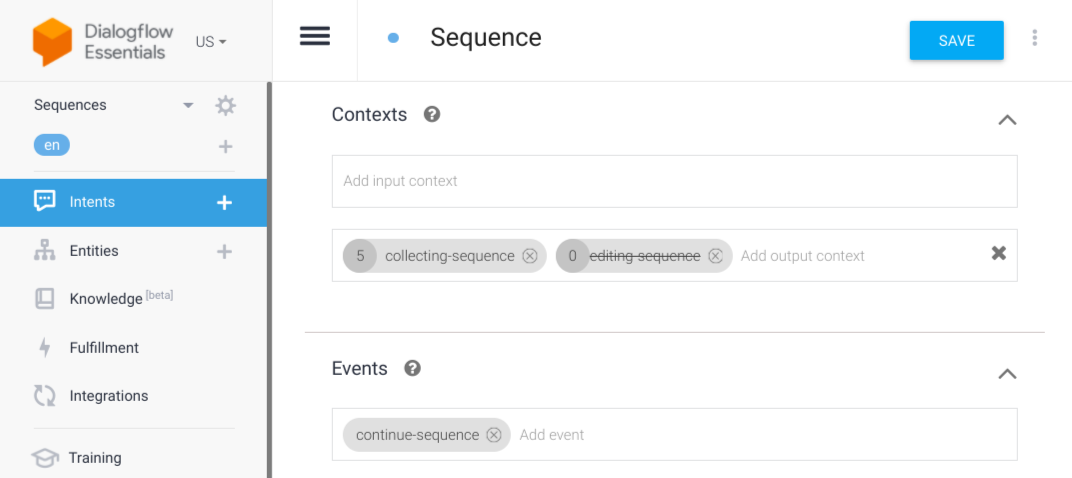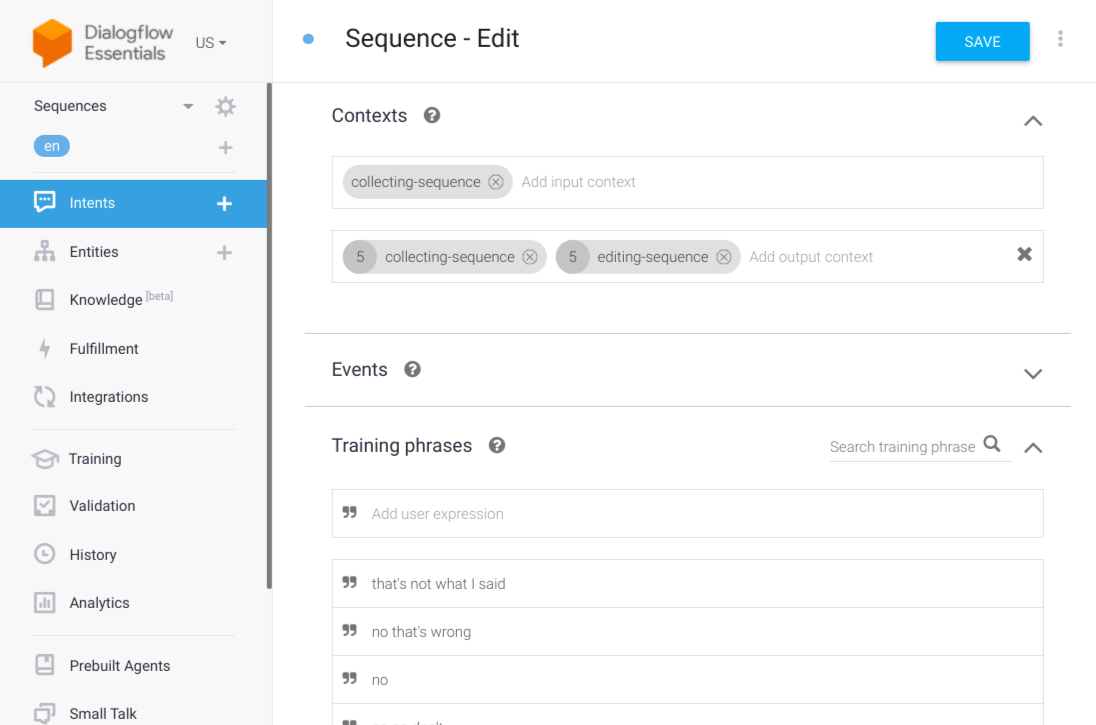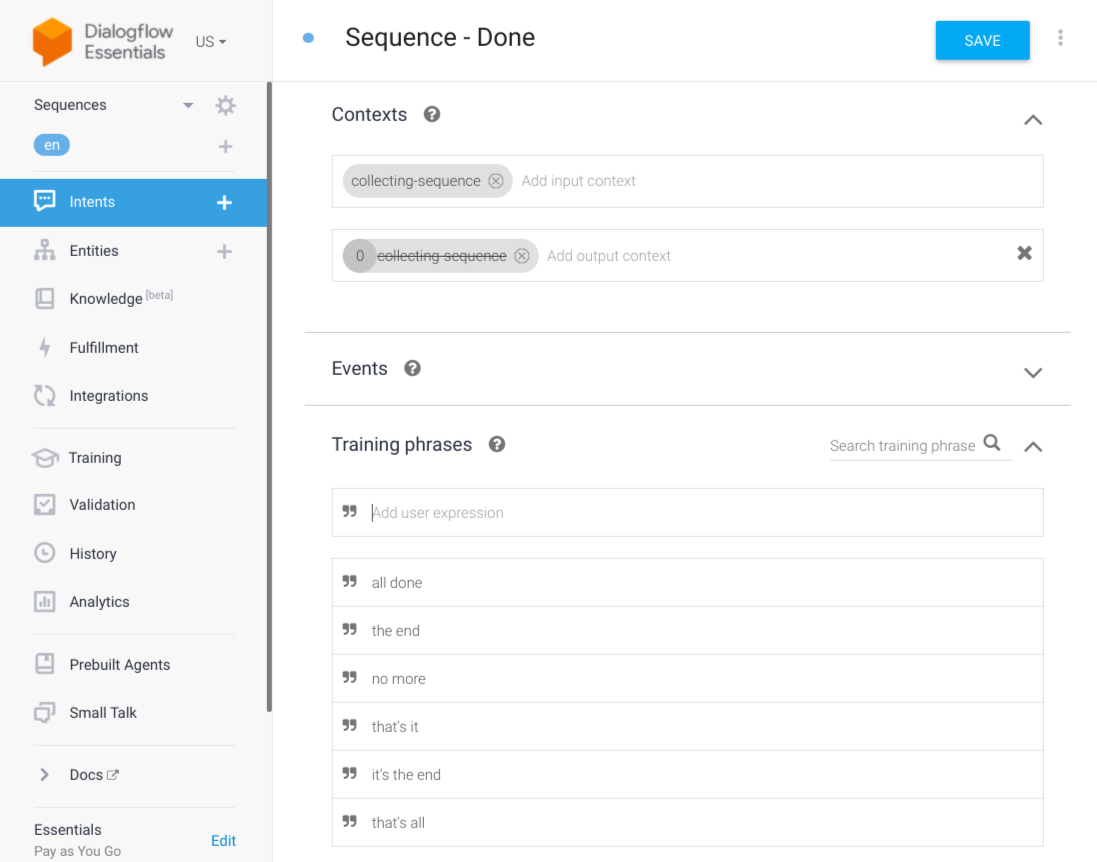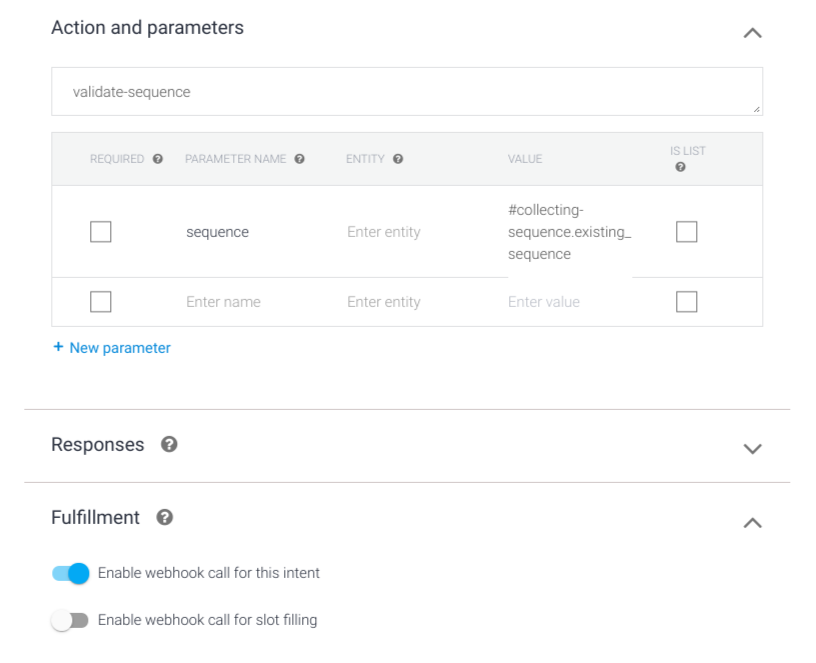Now that you have your sequence entity, you can create the intents to collect the sequence from the end-user. You'll want at least three intents with these responsibilities:
- A head intent "Sequence"
- Catches utterances to start the sequence collection.
- Invoked by follow-up events to continue capturing sequences until the end-user says they're done.
- A contextual intent "Sequence - Edit"
- Catches utterances to correct the last sequence collected.
- Programmatically loops back to the "Sequence" intent to collect the corrected sequence.
- A contextual intent "Sequence - Done"
- Catches utterances that indicate the sequence is complete.
In the next section, you'll see how webhook will connect all of these, but first let's set up the intents.
Create the "Sequence" intent
This is the main intent for collecting sequences. Configure it like so:
- Leave the input contexts empty so end-users can trigger this intent at the start of the call.
- Add an output context "collecting-sequence". We'll use this context to enable the correcting and finishing intents during the flow.
- Add an output context "editing-sequence" and set the lifespan to 0. We'll activate this context with a lifespan from the "Sequence - Edit" intent in the next section, and it's important to clear that context here so that the "editing-sequence" context is only active immediately after triggering the "Edit" intent.
Add an event "continue-sequence" so your webhook can loop this intent to collect all of the partial sequences.

Add training phrases so the end-user can trigger this intent to start the flow. This example uses phrases like "what's my order status", "track my order", "where is my order", etc.
Add an action name "handle-sequence" so the webhook knows when to fire. You'll code the webhook in the next section of this tutorial, after all the intents are set up.
Add a required parameter "new_sequence" using the regexp entity you created to collect partial sequences in the previous section. Set the entity type to "@alphanumeric" and the value to "$new_sequence".
Add an optional parameter "existing_sequence" with value "#continue-sequence.existing_sequence" to extract the new existing sequence from the event. You can leave the entity type empty.
Add an optional parameter "previous_sequence" with value "#continue-sequence.previous_sequence" to extract the previous sequence from the event. You can leave the entity type empty.
Enable webhook call for this intent and webhook call for slot filling.

Create the "Sequence - Edit" intent
This intent listens for utterances that indicate the previous sequence was misheard by the agent. Set it up like this:
- Add an input context "collecting-sequence" so that this intent is only called when we're in the middle of the sequence flow. This is the same context activated by the "Sequence" intent.
- Add an output context "editing-sequence" for our fulfillment webhook to reference. When this intent is activated, the webhook will loop Dialogflow back to the main "Sequence" intent to collect the next sequence. The webhook for the "Sequence" intent's slot-filling will check for an active "editing-sequence" context to provide a sympathetic "try again" response to the end-user.
Add training phrases like "no", "that's not right", etc.

Add the action name "handle-sequence". This is the same action as the "Sequence" intent so we can reuse the same webhook logic.
Add a parameter "new_sequence" with value "#collecting-sequence.previous_sequence" to extract the previous sequence from the context, effcetively undoing the last utterance. We do not add an "existing_sequence" parameter here so that the webhook will overwrite the existing sequence with the previous one.
Enable webhook call for this intent.

Create a "Sequence - Done" intent.
- Add an input context "collecting-sequence"
- Add an output context "collecting-sequence" and set the lifespan to 0 to clear the context. Clearing it prevents the "Edit" and "Done" intents from triggering again now that the agent is done collecting the sequence.
Add training phrases like "that's it", "all done", etc.

Add a parameter "sequence" with value "#collecting-sequence.existing_sequence" to extract the final sequence from the context.
Enable webhook call for this intent.

Link the intents through webhook
You now have everything you need to code the logic for these intents. In the next section, you'll see how to code the webhook to use all these contexts, actions, parameters, and events to complete the sequence validation flow.
